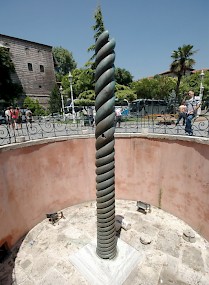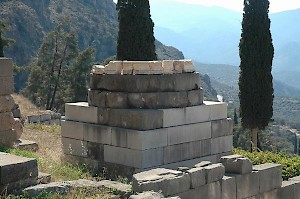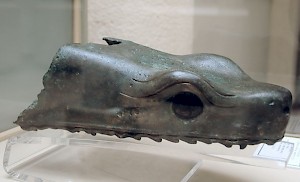Constantinople, Hippodrome, Serpent Column
Q588892Serpent Column: Greek victory monument after the Persian Wars. It originally stood in Delphi but was later transported to Constantinople.

When Constantine the Great had expanded Byzantium and had renamed it Constantinople, he started to decorate the city, and ordered the removal of several ancient works of art and monuments. One of these was the Serpents' Column that had, until then, been in Delphi, and was now placed on the spina, the longitudional barrier in the center of the hippodrome. Here the column still stands between the other monuments: the Obelisk of Theodosius, the Porphyrius monuments, and the Obelisk of Constantine Porphyrogenitus.
It had been erected in 479/478 BCE after the Battle of Plataea, in which the Greeks had defeated the Persians.note The eighteen feet high column had the shape of three snakes, their tails intertwined, carrying, on their heads, a tripod made of gold. On the tripod was written a poem that is (probably incorrectly) attributed to the poet Simonides:
This is the gift the saviors of far-flung Hellas upraised here,
Having delivered their states from loathsome slavery's bonds.note

The original pedestal has been found in Delphi: the monument stood right in front of the temple of Apollo. This may have been a sneer to the Delphian authorities: during the war, the oracle had often sided with the invaders. Every visitor of the sanctuary will have been reminded of the Greek victory - which had been against the odds, at least according to Apollo.
On the coils of the column, an inscription was written that mentioned the Greek city states that had fought the war. They are more or less arranged according to the number of soldiers and/or money they had contributed to the force that had assembled at Plataea.note
| Twelfth coil | Lacedaemonians Athenians Corinthians |
10,000 8,000 5,000 |
||
| Eleventh coil | Tegeans Sicyonians Aeginetans |
1,500 3,000 500 |
||
| Tenth coil | Megarians Epidaurians Orchomenians |
3,000 700 600 |
||
| Ninth coil | Phliasians Troezenians Hermionians |
1,000 1,000 300 |
||
| Eighth coil | Tirynthians Plataeans Thespians |
200? 600 1,800 |
||
| Seventh coil | Mycenaeans Ceans Melians Tenians |
200? - - - |
||
| Sixth coil | Naxians Eretrians Chalcidians |
- 300? 400 |
||
| Fifth coil | Styrians Eleans Potideaeans |
300? - 300 |
||
| Fourth coil | Leucadians Anactorians Cythnians Siphnians |
400? 400? - - |
||
| Third coil | Ambraciots Lepreans |
500 200 |

Herodotus adds the Styreans, Mantineans, Crotoniats, Cephalonians, Lemnians, and Seriphians.
Pausanias tells us that during the Third Sacred War (355-346) "the leaders of the Phocians did not the leave the tripod of gold on its place".note They needed the precious metal to pay mercenaries, because Phocis was threatened by Thebes. Still, the Phocians let the column itself intact; it was left to Constantine to take that to Constantinople. Here, it stood on the spina of the hippodrome. It was later converted into a fountain, and in 1702, the heads were removed - probably by a drunken diplomat. One of the serpent heads has survived and is now in the Archaeological Museum of Istanbul.